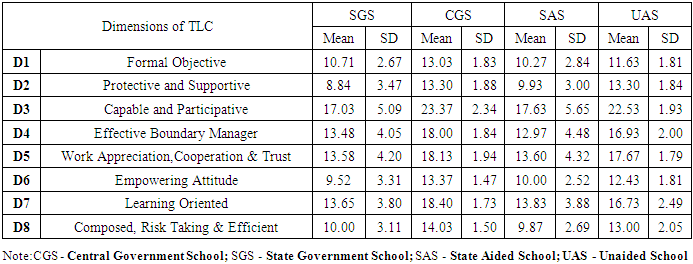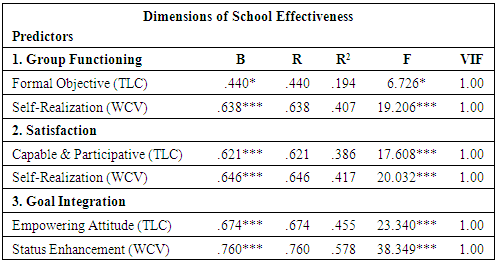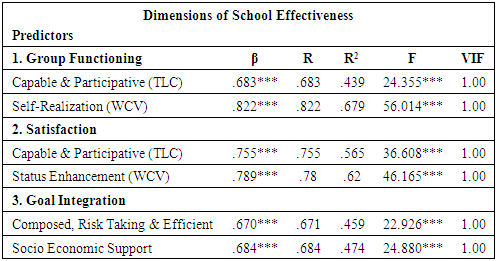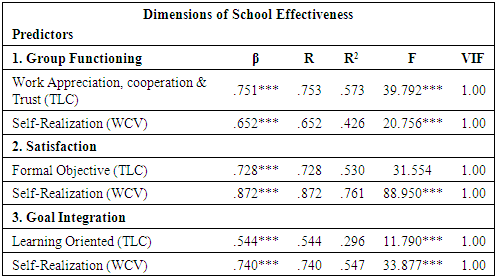-
Paper Information
- Previous Paper
- Paper Submission
-
Journal Information
- About This Journal
- Editorial Board
- Current Issue
- Archive
- Author Guidelines
- Contact Us
International Journal of Applied Psychology
p-ISSN: 2168-5010 e-ISSN: 2168-5029
2021; 11(1): 24-41
doi:10.5923/j.ijap.20211101.03
Received: Dec. 19, 2020; Accepted: Jan. 6, 2021; Published: Jan. 25, 2021

Leadership Competencies and Work Place Values: Keys to School Effectiveness in Public and Private Schools
1Department of Applied Psychology, Shyama Prasad Mukherji College for Women, University of Delhi, Delhi
2Department of Psychology, University of Delhi, Delhi
Correspondence to: Anamika Rai, Department of Applied Psychology, Shyama Prasad Mukherji College for Women, University of Delhi, Delhi.
| Email: |  |
Copyright © 2021 The Author(s). Published by Scientific & Academic Publishing.
This work is licensed under the Creative Commons Attribution International License (CC BY).
http://creativecommons.org/licenses/by/4.0/

The present study aimed to investigate teachers’ perception regarding their principal’s leadership competencies, work culture values and school effectiveness (SE). With the help of purposive sampling method 120 teachers were selected from different management type schools (i.e., central, state, state aided and private unaided). Findings reveal that maximum number of teachers perceived their principals’ as ‘capable and participative’. Regarding teachers’ work culture values, self-realization and socio-economic support were found to be highly valued and practiced. The patterns of mean scores on all the variables were found constantly high in central and private schools whereas low in state schools. Regression results revealed that self-realization values were found as a common predicting variable for almost all the components of SE. The critical perspective of these findings is useful in understanding how this set of key variables as a whole defines the effectiveness of schools at all levels.
Keywords: Transformational leadership competencies (TLC), Work culture values (WCV), School Effectiveness (SE), Principals and Teachers, Public and private schools
Cite this paper: Anamika Rai, Anand Prakash, Leadership Competencies and Work Place Values: Keys to School Effectiveness in Public and Private Schools, International Journal of Applied Psychology, Vol. 11 No. 1, 2021, pp. 24-41. doi: 10.5923/j.ijap.20211101.03.
1. Introduction
- Initial decision to work on school effectiveness (SE) evoked many questions into my mind. How can we say that this school is better and this is not? What one may count in the defining frame of effective schools? What are those practices, which make school performance better? In the same line, Wyatt (1996) emphasized that after more than two decades of research into school effectiveness, it is important to question what we have learnt and achieved so far. He further states, ‘regardless of the voluminous literature on SE, we are not much further advanced from the state of affairs described in Ralph and Fennessy's (1983) critique – ‘much of the literature takes the form of reviews of reviews, with only a small number of highly influential empirical studies providing the "evidence" cited in paper after paper’ (in Wyatt, 1996). Cameron and Whetten (1983) argue, the definitions, models and criteria of organizational effectiveness are so diverse that a single clear definition is impossible, as organizations may have multiple and often contradictory goals at different levels. The closer view depicts that all schools are unique in their own ways, and many factors combine to make them what they are. In such condition, stating that all schools work on a set pattern and fabricated with specific factors is neither easy nor correct. However, it is possible to identify a set of common characteristics like school culture, leadership, teachers’ trust in head teacher or their own colleagues, etc. (Uline, Miller & Tschannen-Moran, 1998) that may contribute to the effectiveness of the school. Literature suggests that different schools of thought/discipline have conceptualized SE in different ways. For instance, educationists have given more importance to enrollment, retention, and dropout rates (Kochan, Tashakkori, & Teddlie, 1996), whereas many have seen it in terms of students’ performance, academic achievement or success rate (Coleman et al., 1966; Mott, 1972). Among the existing measures of school effectiveness, student achievement, as operationalized by standardized scores in mathematics and reading seem to be the predominant measure (Peterson, 1984; Sweetland & Hoy, 2000). These two measures deal with the input and output aspects of SE.Others have viewed SE in terms of classroom pedagogy or teaching learning, the content aspect (Uline et al., 1998; Creemers, 1994; Cohen, 1983; and Scheerens, 1992) and in addition to this, large sections of management and educational researches have also viewed effectiveness in terms of process aspects and uses additional measures to evaluate school effectiveness (Sweetland & Hoy, 2000; Silins & Harvey, 1999). Uline, Miller and Tschannen-Moran (1998) have classified the measures of reading, writing and arithmetic as instrumental activities. They have also discussed an additional criterion to measure effectiveness and have named them as expressive activities. Expressive activities included teachers’ trust in colleagues and principal and school health (served as a basic framework of this current study) explained 72% of the variance in effectiveness (Uline et al., 1998). In Indian context, the term school effectiveness has been interchangeably used with school quality (Adams, 1997). Thus, it is imperative for us to review the growing international and national research literature on school quality as well in our endeavor to gain insights into the theoretical perspectives. In practice, quality and its concepts are usually defined as outputs, outcomes, processes or inputs. This refers to the degree to which the objectives are met or desired levels of accomplishment are achieved. Recent researches go beyond the prevailing trend of analyzing the impact of schools, classroom processes and education on students’ educational performance and move towards studying other factors those with-in schools, the identification of a reasonably consistent set of school characteristics that contribute to enhanced educational outcomes (Teddlie & Reynolds, 2000). We may say that in the intervening years, the factors of SE researches specifically in international context have explored a cluster of indicators by focusing more on process aspect. While measuring SE, the process model assumes that a school is effective if its internal functioning is smooth and "healthy". Therefore, according to this model, the internal organizational activities and practices in schools are regarded as important criteria of school effectiveness (Cheng 1993). Thus, it serves as a basic framework of this study. Review of enormous and vast researches on SE (Cheng, 1996; Mott, 1972; Reynolds, et. al., 1996; Sammons, et. al. 1995, 1999) has revealed that following the process model, researcher have identified effectiveness indicators in terms of leadership, school atmosphere, communication channels, participation etc. Perhaps Hechinger (1981) best summarizes the matter when he states, “I have never seen a good school with a poor principal or a poor school with a good principal”. In his pioneer study of effective schools placed leadership at the top of his list of characteristics that distinguished such institutions. Curran (1983) in placing the importance of the principal as being an active leader at the top of his list of 11 effective school factors noted, “Leadership is the ultimate necessity for any successful group, organization, or endeavor. Leadership competencies have been defined in many ways, but they are causally related to success or performance (Wright, 2008). According to Garman & Johnson, (2006) competencies are relevant outcome measures to assess knowledge, skills and abilities. Leadership competencies may be defined in terms of characteristics of a leader with behavioral implications that are thought to associate with successful performance of their job. As stated by Boyatzis (1982), competence means different things to different people. However, it is generally accepted as encompassing knowledge, skills, attitudes and behaviours that are causally related to superior job performance. A definition of "competency" adopted from Parry's (1998) work is "a cluster of related knowledge, attitudes, skills, and other personal characteristics that affects a major part of one's job, correlates with performance on the job, can be measured against well-accepted standards, can be improved via training and development and can be broken down into dimensions of competencies". The major components of competencies include: abilities, attitudes, behaviour, knowledge, personality and skills. Transformational leadership competencies framework shifts the focus from leading to building new leaders. James MacGregor Burns (1978), writing in his book ‘Leadership’ was the first to put forward the concept of ‘transforming leadership’. To Burns, transforming leadership is a relationship of mutual stimulation and elevation that converts followers into leaders and may convert leaders into moral agents. Many have viewed it in altogether different shades. Like, Kouzes and Posner (2007, 2009) have viewed transformational leadership into five critical competencies i.e. modeling the way, inspiring a shared vision, challenging the process, enabling others to act, and encouraging the heart. According to Bass & Avolio (1994, 1995) transformational leadership include five indices (5I’s), which are idealized influence (attributed), idealized influence (behavior), inspirational motivation, intellectual stimulation, and individualized consideration). Hooper and Potter (1997) extended this notion of transformational leadership by identifying seven key competencies, i.e. setting direction, setting an example, communication, alignment, bringing out the best in people, the leader as a change agent, and providing decision in a crisis and an ambiguous situations, of transcendent leaders.In an Indian scenario, Sinha (2004) has defined competencies as individual characteristics, which is causally related to effective or superior performance in a job or situation. He further states that competencies may be divided into two categories. First, the threshold competencies that are the essential characteristics, and second, the differentiating competencies, i.e. the factors that distinguish superior from average performers. There could be five types of competency characteristics in the main. They are the following: motives, traits, self-concept, knowledge, and skill. Out of these five, the skill and the knowledge may be regarded as belonging to the surface of the people and are more visible, whereas the self-concept, traits, and motives are relatively hidden and could be more difficult to access and develop. Hence, skill and knowledge competencies may be more amenable to training attempts and may be relatively easy to develop. Bitterová, Hašková and Pisonová (2014) described the quality of school leaders and managers as one of the fundamental factors that significantly affect the quality of teaching and learning processes at each level of the education system. The authors carried out a study aimed at defining both the importance of specific items in a profile of a school leader's competence and the needs and requirements of school leaders derived from their actual daily practice. The results showed in the four areas of management area competence, practicing school leaders consider the most critical competencies of a school leader profile to establish motivational strategies focused on common school values, competency to create and develop an effective learning atmosphere for the learning of pupils and students, competency to clearly identify, distribute and assign resolutions. Jamal (2014) reviews research literature in order to evaluate the most successful leadership model in the current school management conditions. In order to achieve this objective, a consistent literature review was carried out on the following subjects: evolution of leadership; types of transformative and transactional leadership; the links between a leadership style and organizational variables; the relationship between value systems and leadership styles of school’s principles. During the study of leadership evolution, techniques, processes, models, and means are studied. The literary review indicates that transformational leadership essentially improves the functioning of school and teaching processes. it is determined that principals with a moral value system lean more towards a transformational leadership style and principals with a pragmatic value system lean more towards a transactional leadership style.In 2016, Goksoy, evaluated the levels of leadership competencies that the deputy principals experience, their impressions of their personal characteristics, and the organization's atmosphere. In the analysis, results were found that Deputy Principals regard themselves as leaders in terms of personal characteristics and behaviors. In terms of management, the competencies of deputy principals are: technical, interpersonal, conceptual and cognitive competencies. Trakšelys, Melnikova, and Martišauskienė (2016) took the development of competencies of school heads as an object of study, conceptualized in the form of paradigms of education management. It is argued that school leaders are responsible for controlling the educational process, managing and running the school, redesigning the school and setting the course. In addition, it is claimed that the introduction of an integral model of leadership (which incorporates instructional, transactional and transformative leadership) presupposes school progress in the structural change paradigm. It is disclosed that school heads must have a comprehensive capacity that requires those competencies under the conditions of structural change: management of educational process, strategic, operational, interpersonal, personal, continuous learning as well as dimensions of emotional intelligent, critical thinking and diagnostic competency.Lastly, as a mediating variable, culture has a powerful effect on the performance and long-term effectiveness of organizations (Cameron & Ettington, 1983). Schein (1985) contends that the most important function of a leader is the creation and molding of organizational cultures. They encourage autonomy and assists in creating such an organizational culture, which results in both leader and follower being elevated to a higher level of motivation and morality (Burns, 1978). Quality cultures are conducive to enhancing work environments and may have a positive impact with areas such as worker satisfaction, communication, effectiveness, innovation and creativity in the organizations (Schein, 1996). Abdullah, Ling, and Hassan (2018) identified the impact on the culture of teachers of the importance of teacher work. A total of 540 randomly chosen teachers were selected as respondents in the study from 36 secondary schools in Penang. The results of the study have shown that the working importance variables of teachers and school culture are at moderate levels. Furthermore, the findings also show the value of teachers' work, especially the dimensions of engagement, pride, improvement, and activity have a significant influence on school culture. Therefore, the findings of this study suggest that educators need to learn, improve, and transform existing values so as to foster a better personality and add value to their working environment. Schein (1987) argues that those occupying the top positions have the largest span of control, greater access to resources and the highest visibility. Researchers have found leadership as a core construct influence the organizational culture. As Schein (1992) observes that organizational culture and leadership are intertwined and culture creation, culture evolution, and culture management are what ultimately define leadership. He illustrates this inter-connection by looking at the relationship between leadership and culture in the context of the organizational life cycle. Özgenel (2020) decides whether the school climate impacts school effectiveness. For this reason, the analysis used a hierarchical screening model for quantitative research. In the 2018-2019 academic year, the study was performed and 341 teachers participated voluntarily. Correlation and regression analysis analyzed the results. School environment predicts school performance, according to the findings. It was concluded that there is a positive and essential correlation between the efficacy of school and the principal behaviors of help and directive, and the behaviors of intimate and collegial teachers. In other words, at various levels and positively, the actions of supportive and directive principals and collegial teacher behaviors have influenced school performance.Thus, viewing the importance of leadership and organizational culture in understanding school effectiveness via process model and considering teachers and principals as the most stable entities and important stakeholders of the entire organization, this study tries to analyze the perceived school effectiveness along with transformational leadership competencies of principals and work culture values of teachers from their perspectives. Research Questions1. What set of leadership competencies work in schools?2. As a function of culture, what work related values are being practiced at schools?3. Does the ownership of school like – government and private schools has any relationship with regard to the leadership competencies, cultural practices and its impact on school effectiveness?Objectives - The study focuses on these specific objectives as follows:1. To understand transformational leadership competencies, work related values and school effectiveness in both public and private schools.2. To explore the relationship and identify the predictors of school effectiveness from between the different dimensions of antecedent variables i.e. transformational leadership competencies, work culture values in both public and private schools.Variables - Antecedent Variables • Transformational Leadership Competencies• Organizational Culture Outcome Variable• Organizational EffectivenessProposed framework of the studyIn relation to the purpose of this study, a theoretical framework has been proposed to illustrate the vital link between the antecedent, intermediate and outcome variables in the form of a schematic diagram (fig 1) which shows the relationship between transformational leadership competencies and school effectiveness with a mediating role of organizational work culture values.
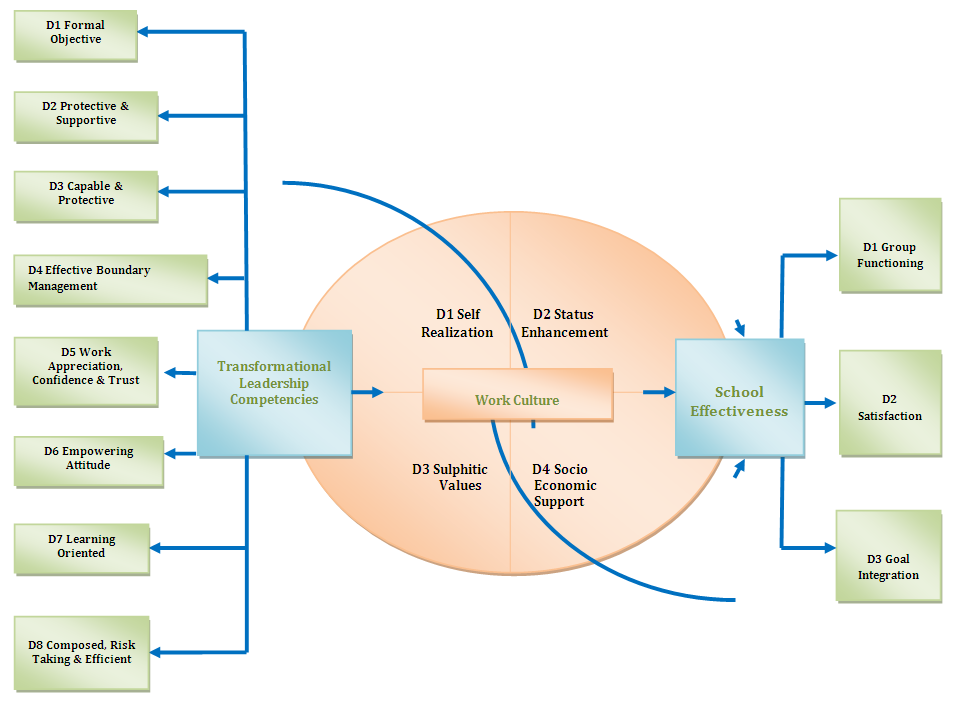 | Figure 1. Research Framework - Relationship between TLC & SE with a mediating variable of WCV |
2. Method
- Design of the StudyThis study was ex-post facto in nature. All the teachers of urban higher secondary schools were considered as the population for this study. A sample of 120 teachers was drawn with the help of purposive sampling technique. Quantitative data was obtained from teachers by using standardized tools of transformational leadership competencies, work culture values and school effectiveness. Sample selection ProcessThe sample was drawn based on purposive sampling technique. As the number of government schools (3) and the number of those teachers who have served their institutions for at least 3 – 5 years were limited, care was taken to select the sample of at least 30 participants in each management type schools, so as to apply the inferential statistics successfully. The total sample was comprised of 120 teachers and their corresponding school principals of government and private higher secondary schools of Allahabad district.
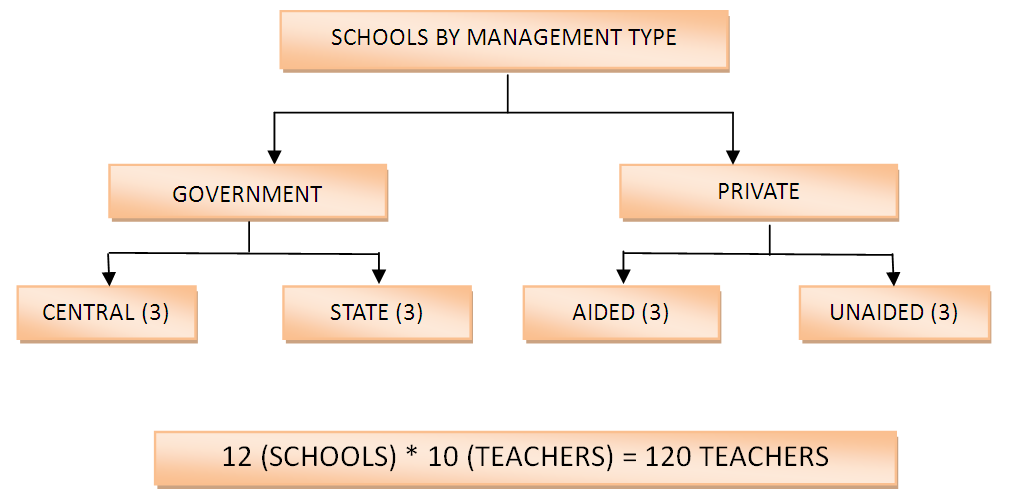 | Figure 2. Sample selection process |
3. Results & Discussion
- 1. Exploration of antecedent and outcome variables in different management type schoolsTransformational Leadership Competencies (TLC)It was assumed that the effectiveness of school is shaped by the transformational leadership competencies (TLC) within certain cultural characteristics perceived by the teachers of the school. Based on their perception, the findings of this study demonstrated that TLC was being practiced differently in public and private schools. Results revealed that the scores on the dimensions of TLC (Table 1), shows that teachers have perceived their principal as transformational leader exhibiting the competence of being capable and participative which is constantly scored highest in all types of schools.
|
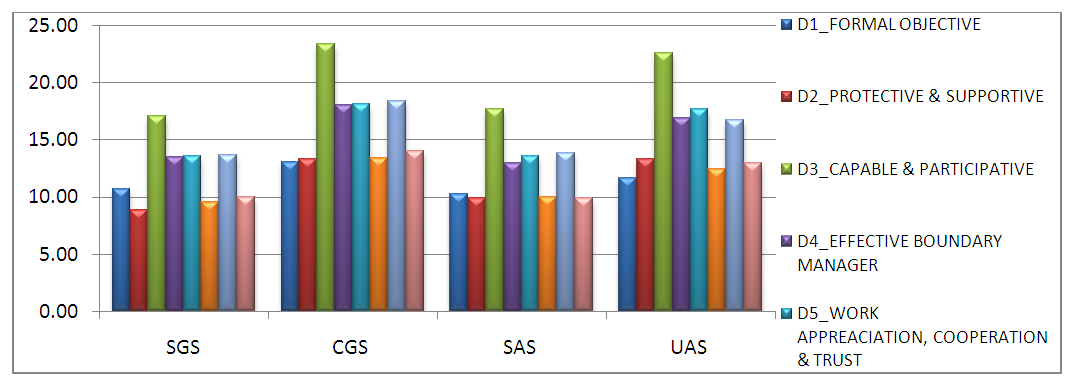 | Figure 3. Mean Scores of Different Components of TLC in Different Management Type Schools |
|
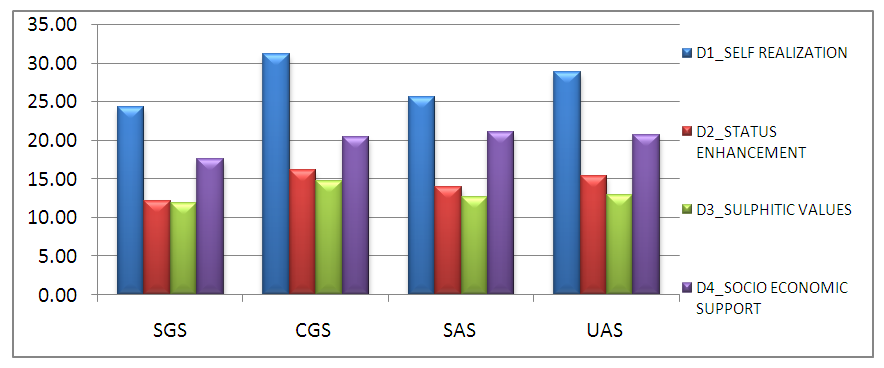 | Figure 4. Mean Scores of different Dimensions of WCV in different Management Type Schools |
|
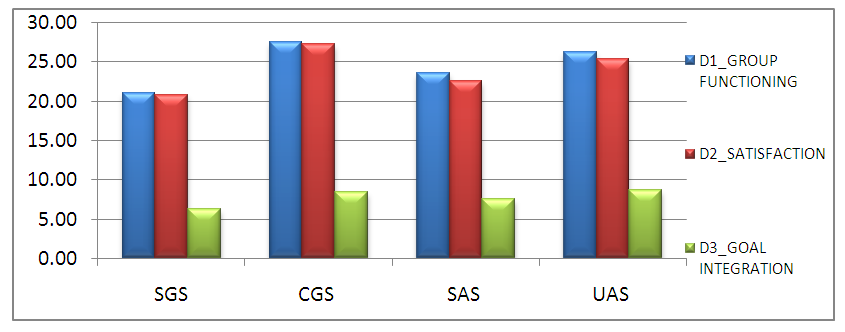 | Figure 5. Mean Scores of different Dimensions of SE in different Management Type Schools |
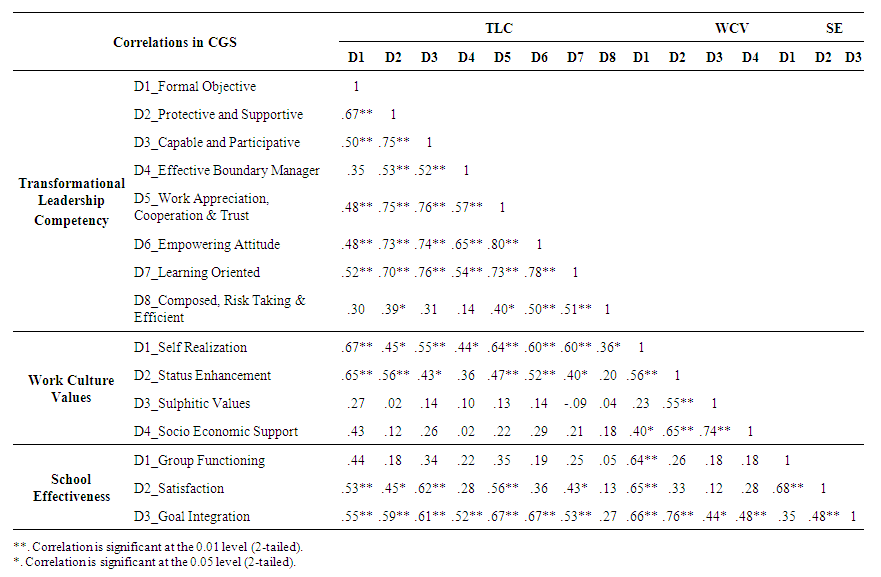 | Table 4. Inter-Correlation among Transformational Leadership, Work Culture Values & School Effectiveness in Central Government Schools |
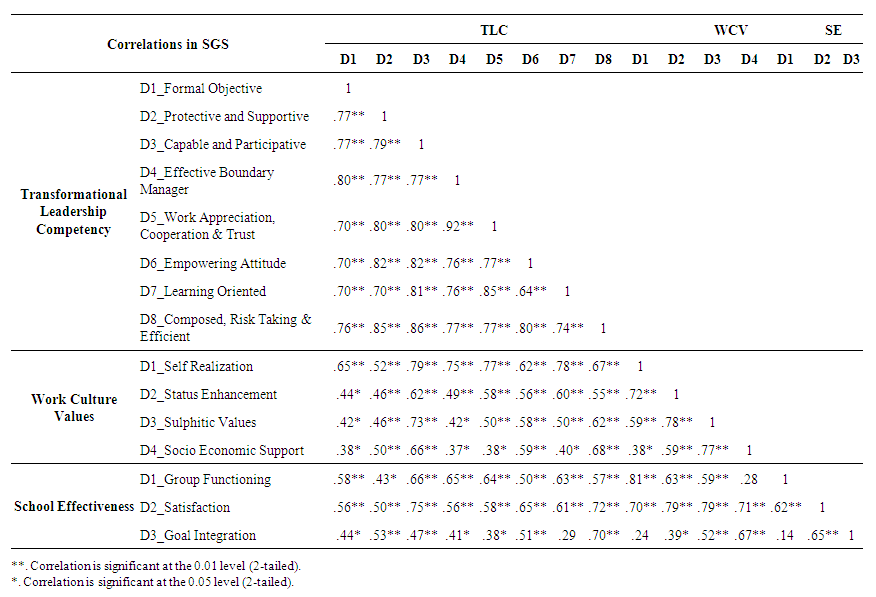 | Table 5. Inter-Correlation among Transformational Leadership, Work Culture Values & School Effectiveness in State Government Schools |
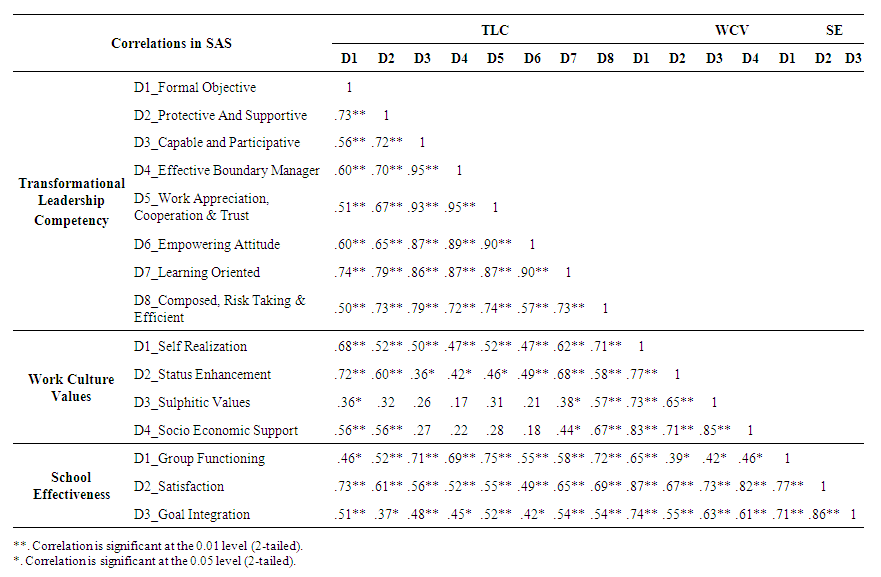 | Table 6. Inter-Correlation among Transformational Leadership, Work Culture Values & School Effectiveness in State Aided Schools |
 | Table 7. Inter-Correlation among Transformational Leadership, Work Culture Values & School Effectiveness in Unaided Schools |
|
|
|
|
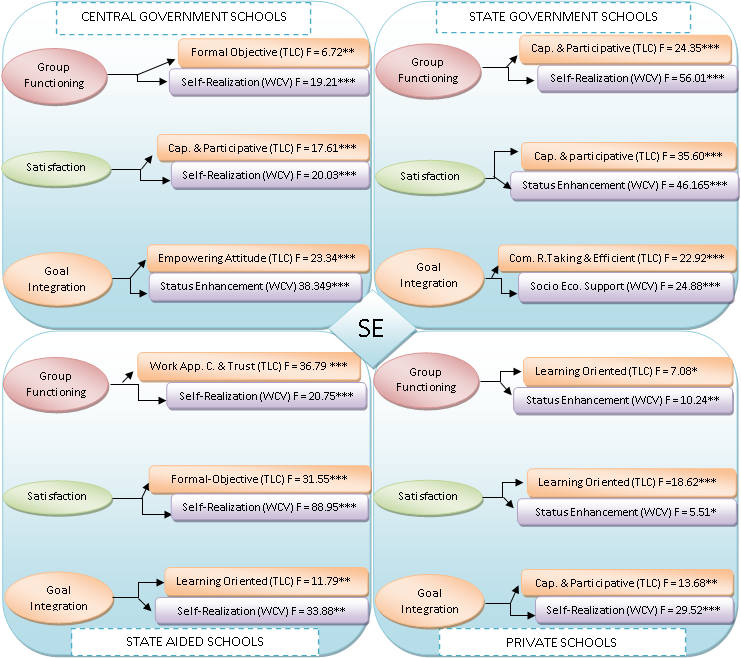 | Figure 6. Predictors of School Effectiveness in Different Management Type of Schools |
4. Conclusions
- This study clearly demonstrated that principals’ leadership influence and cultural characteristics play a crucial role in predicting perceived school effectiveness. It rejected all the null hypotheses formulated in this study and showed that central and private schools were performing better in terms of exhibiting transformational leadership competencies, work culture values and school effectiveness as compared to state owned schools. Between these two types of schools, centrally owned schools showed highest scores which ultimately helped them in establishing smooth and healthy internal functioning for the success of their school organizations. Theoretical perspectives considered clarifies, that in school organizations, shaping the culture is the central and important function of principals as leaders. Broadly speaking, school transformation and success depend directly upon the principal’s leadership competencies, which, in turn helps create the necessary work culture conducive to teachers’ motivation, commitment, and performance. A principal’s leadership influence can enhance, encourage and nurture a positive school culture. Thus, leadership traits continue to be studied so that principals can strive for a more comprehensive understanding of how to mould a school culture in a positive way to enhance the school performance. There are no ultimate panaceas nevertheless, there are some positive and encouraging possibilities. As principals and teachers are the two important wheels of any school organization, influential leadership competencies and high quality teachers may become the hallmark of its success or improved school performance. However, effective leadership is not the result of simply obtaining a position rather possessing the knowledge and understanding of leadership competencies along with personal abilities to implement those skills effectively. Hence, principals as a school leader need notable skills precisely the transformational ones, to produce effective influence and transformations, in our diverse school environments. In any educational system, teachers are the most important group of professionals, the source of existence, energy and enrichment for our nation’s future. In the process of social reengineering and national construction, quality teachers and their teaching could be the strong agents. They play an important role in the achievement of desired transformation and improvement of the educational system. In ancient times, teachers occupied a predominant role in the ‘man making process. The society looked upon the ‘Acharya’ for their valuable suggestions and guidance. Due to globalization and technological changes, teaching in the modern era has become a challenging profession which requires good command on subject knowledge, effective skills of teaching through different ways and above all high moral quotient.If schools are to become more effective, the investment in teachers’ efficiency and proficiency must increase along with principals’ enhanced leadership skills. It is a challenge for school principals and educators to promote and establish such programs that may influence teacher skills and abilities with a confidence that school effectiveness will also be enhanced. As new materials, new buildings and facilities, new organizational schemes, new curricular packages and arrangements, new delivery systems and new programs will not guarantee school effectiveness, we need to redefine the existing ones. We need to redefine the patterns of working, teaching and learning with better, healthy and positive school culture, which may provide better opportunities for growth and development to both teachers and students and other staff members. Hence, in an Indian school, the welfare of the teacher and principals should be of supreme concern who in turn must be sensitive to an entire body of unique and special factors of schools, which equate to success in that particular educational environment.
5. Implications
- This study highlights that principals’ leadership competencies, teachers’ work culture values and their perceived school effectiveness had a variety of implications in policy and practice specifically in the context of central and state government schools. Now at this juncture we need a serious consideration of how these findings may be meaningfully understood and applied to enhance principals’ leadership behavior, cultural practices and teachers’ work life. The following implications can be made based on the findings for the school included - 1. Based on the results of different patterns of predictors in different schools, it may be implied that principals’ as a transformational leader may try using the different competencies, such as being capable – participate and formal – objective, relatively, more frequently. 2. Understanding teachers’ professional work values are also important, as it may help the school administration to identify teachers in a holistic framework and align values with educational goals.3. Supportive work culture of appreciation, cooperation and trust may provide better opportunities to teachers to align their self-realization values. By providing better and trustworthy working conditions, teachers will be more satisfied to work in the institution they are working.4. We may use the findings of this study while selecting, recruiting, or training school principals as the awareness of teachers’ perceptions and expectations could lead to better school administration and principal-teacher relations, though it is a daunting task in need of employment scenario in our country. 5. These results may also be helpful to the authorities who are responsible for planning and making educational policies and offering pre-service and in-service training programs for the prospective and present school principals.6. In order to function effectively, school principals need to enhance their leadership competencies vital to organizational effectiveness.7. For teachers’ overall satisfaction, principals need to create an open and collegial work environment, in which teachers may feel good about their work and jobs. They may able to expresses their genuine feelings and opinions, and cooperate with each other on important decisions. Precisely, it should be a culture of ‘asking’ rather than ‘telling’ (Schein, 2013).8. If schools are to attract and retain their best teachers, those aspects of the job that influence teacher satisfaction and motivation must be considered. Focusing on intrinsic values may facilitate teachers to utilize their skills to the fullest and help them to enhance group functioning, satisfaction and goal integration as major components of perceived school effectiveness. 9. Positive feedback and guidance to teachers are also important to make them aware of their duties and work settings, as it may help them to adjust with the school conditions and cultural practices effectively.10. Clear-cut guidelines and messages are essential for reducing role conflict and enhancing the clarity of institutional goals, so that teachers may have better compatibility and integration with their individual and school goals. 11. For policy makers and higher educational authorities, it is obligatory to understand the causes behind teachers’ entry into the profession and values they hold. Because, if there is a possibility of making a contribution in the growth and learning of the organization or students, it could be the most encouraging element when attempting to improve school effectiveness, keeping in view the moral nature of organizations.12. Above all, schools must be ensured with the optimal availability and utilization of basic sanitation, health and teaching – learning facilities.
 Abstract
Abstract Reference
Reference Full-Text PDF
Full-Text PDF Full-text HTML
Full-text HTML